Project Management in Business: RAMBOLL Construction Project Report
VerifiedAdded on 2019/12/03
|24
|5905
|171
Project
AI Summary
This project management report examines the application of project management principles within the context of a construction project undertaken by RAMBOLL, a consultancy and construction organization. The report begins with an introduction to project management, outlining its core principles, including initiation, planning, execution, monitoring, and closing, and their impact on project success. It then explores project viability using NPV and payback period methods, and establishes success and failure criteria. The report delves into the principles behind project management systems and procedures, emphasizing the importance of knowledge, resource allocation, and quality management. Key elements of project termination and post-project appraisal are discussed, including variance analysis, cost-benefit analysis, and risk analysis. Furthermore, the report analyzes the organizational structure, roles, and responsibilities within a project, advocating for a matrix structure for the RAMBOLL project. Project control and coordination are addressed through the application of Work Breakdown Structure (WBS) and Gantt charts. The report also covers project scheduling, cost estimation, and change control procedures, providing a comprehensive overview of project management practices.
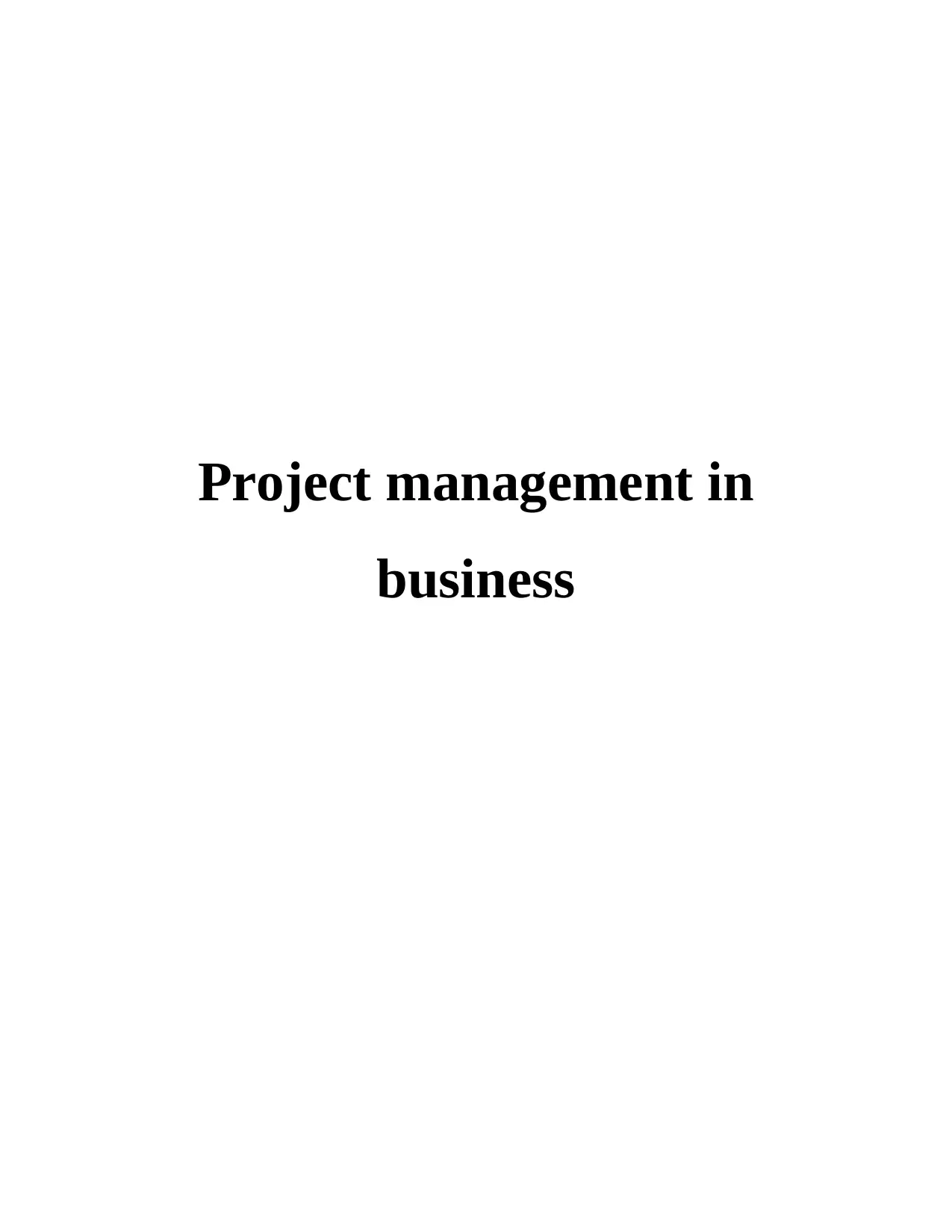
Project management in
business
business
Paraphrase This Document
Need a fresh take? Get an instant paraphrase of this document with our AI Paraphraser
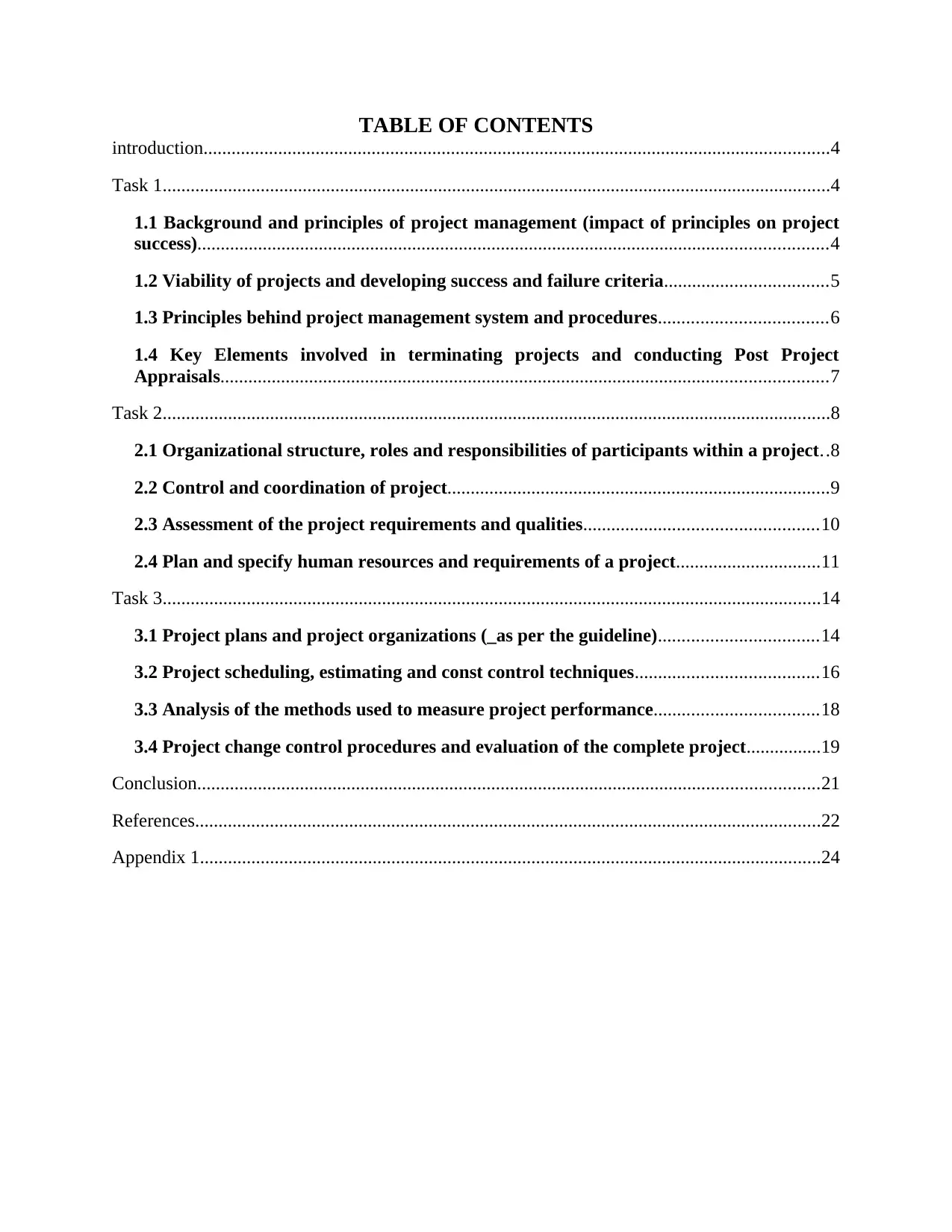
TABLE OF CONTENTS
introduction......................................................................................................................................4
Task 1...............................................................................................................................................4
1.1 Background and principles of project management (impact of principles on project
success).......................................................................................................................................4
1.2 Viability of projects and developing success and failure criteria...................................5
1.3 Principles behind project management system and procedures....................................6
1.4 Key Elements involved in terminating projects and conducting Post Project
Appraisals..................................................................................................................................7
Task 2...............................................................................................................................................8
2.1 Organizational structure, roles and responsibilities of participants within a project..8
2.2 Control and coordination of project..................................................................................9
2.3 Assessment of the project requirements and qualities..................................................10
2.4 Plan and specify human resources and requirements of a project...............................11
Task 3.............................................................................................................................................14
3.1 Project plans and project organizations (_as per the guideline)..................................14
3.2 Project scheduling, estimating and const control techniques.......................................16
3.3 Analysis of the methods used to measure project performance...................................18
3.4 Project change control procedures and evaluation of the complete project................19
Conclusion.....................................................................................................................................21
References......................................................................................................................................22
Appendix 1.....................................................................................................................................24
introduction......................................................................................................................................4
Task 1...............................................................................................................................................4
1.1 Background and principles of project management (impact of principles on project
success).......................................................................................................................................4
1.2 Viability of projects and developing success and failure criteria...................................5
1.3 Principles behind project management system and procedures....................................6
1.4 Key Elements involved in terminating projects and conducting Post Project
Appraisals..................................................................................................................................7
Task 2...............................................................................................................................................8
2.1 Organizational structure, roles and responsibilities of participants within a project..8
2.2 Control and coordination of project..................................................................................9
2.3 Assessment of the project requirements and qualities..................................................10
2.4 Plan and specify human resources and requirements of a project...............................11
Task 3.............................................................................................................................................14
3.1 Project plans and project organizations (_as per the guideline)..................................14
3.2 Project scheduling, estimating and const control techniques.......................................16
3.3 Analysis of the methods used to measure project performance...................................18
3.4 Project change control procedures and evaluation of the complete project................19
Conclusion.....................................................................................................................................21
References......................................................................................................................................22
Appendix 1.....................................................................................................................................24
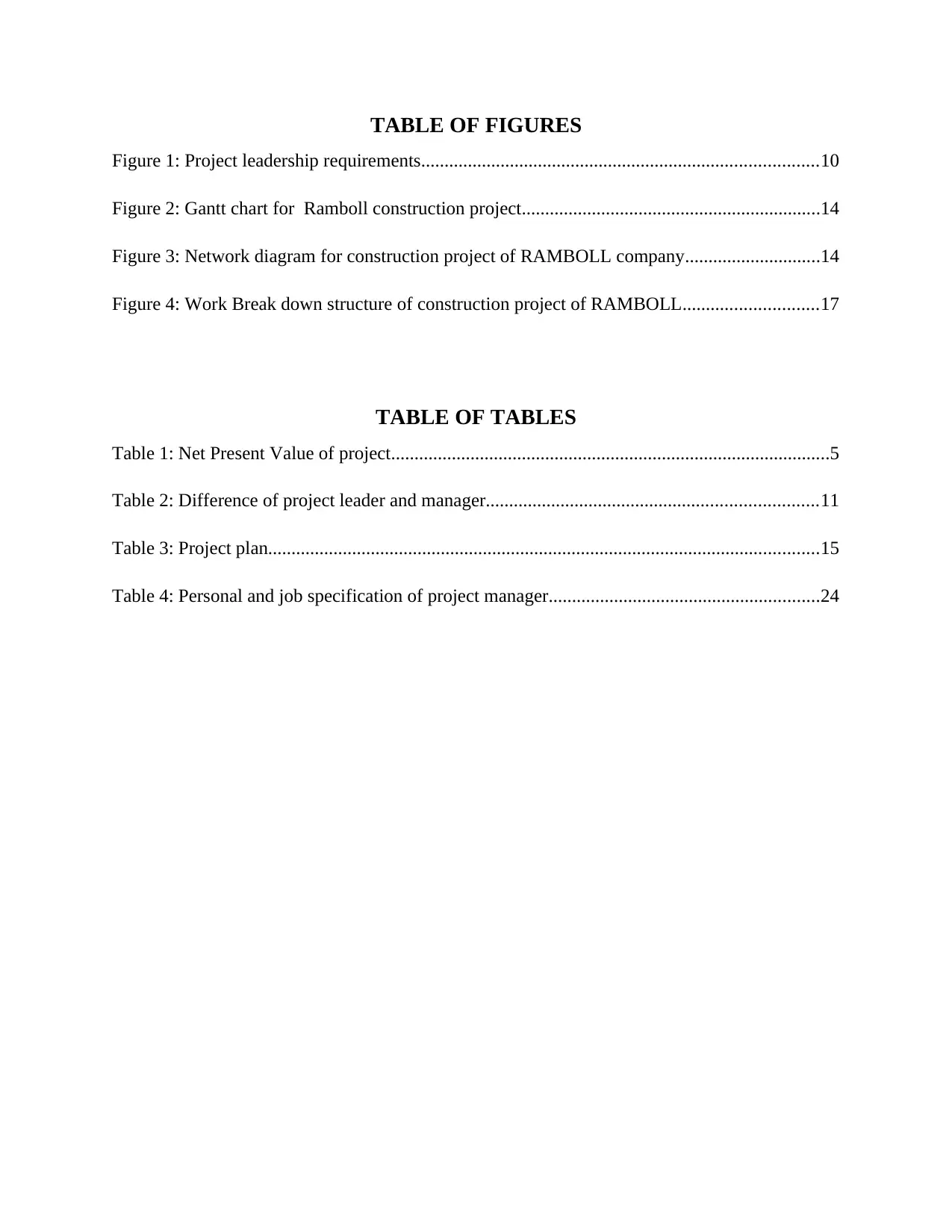
TABLE OF FIGURES
Figure 1: Project leadership requirements.....................................................................................10
Figure 2: Gantt chart for Ramboll construction project................................................................14
Figure 3: Network diagram for construction project of RAMBOLL company.............................14
Figure 4: Work Break down structure of construction project of RAMBOLL.............................17
TABLE OF TABLES
Table 1: Net Present Value of project..............................................................................................5
Table 2: Difference of project leader and manager.......................................................................11
Table 3: Project plan......................................................................................................................15
Table 4: Personal and job specification of project manager..........................................................24
Figure 1: Project leadership requirements.....................................................................................10
Figure 2: Gantt chart for Ramboll construction project................................................................14
Figure 3: Network diagram for construction project of RAMBOLL company.............................14
Figure 4: Work Break down structure of construction project of RAMBOLL.............................17
TABLE OF TABLES
Table 1: Net Present Value of project..............................................................................................5
Table 2: Difference of project leader and manager.......................................................................11
Table 3: Project plan......................................................................................................................15
Table 4: Personal and job specification of project manager..........................................................24
⊘ This is a preview!⊘
Do you want full access?
Subscribe today to unlock all pages.

Trusted by 1+ million students worldwide
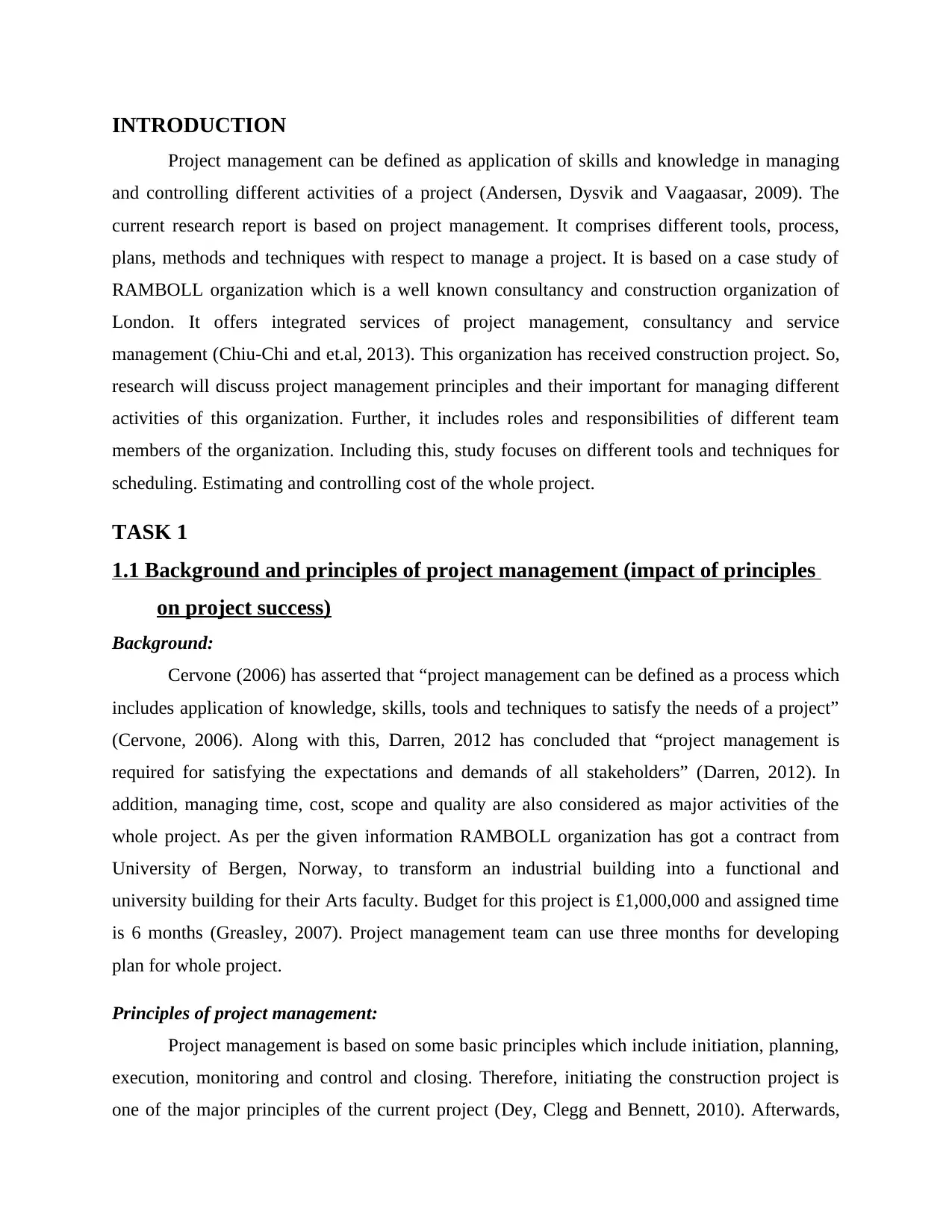
INTRODUCTION
Project management can be defined as application of skills and knowledge in managing
and controlling different activities of a project (Andersen, Dysvik and Vaagaasar, 2009). The
current research report is based on project management. It comprises different tools, process,
plans, methods and techniques with respect to manage a project. It is based on a case study of
RAMBOLL organization which is a well known consultancy and construction organization of
London. It offers integrated services of project management, consultancy and service
management (Chiu-Chi and et.al, 2013). This organization has received construction project. So,
research will discuss project management principles and their important for managing different
activities of this organization. Further, it includes roles and responsibilities of different team
members of the organization. Including this, study focuses on different tools and techniques for
scheduling. Estimating and controlling cost of the whole project.
TASK 1
1.1 Background and principles of project management (impact of principles
on project success)
Background:
Cervone (2006) has asserted that “project management can be defined as a process which
includes application of knowledge, skills, tools and techniques to satisfy the needs of a project”
(Cervone, 2006). Along with this, Darren, 2012 has concluded that “project management is
required for satisfying the expectations and demands of all stakeholders” (Darren, 2012). In
addition, managing time, cost, scope and quality are also considered as major activities of the
whole project. As per the given information RAMBOLL organization has got a contract from
University of Bergen, Norway, to transform an industrial building into a functional and
university building for their Arts faculty. Budget for this project is £1,000,000 and assigned time
is 6 months (Greasley, 2007). Project management team can use three months for developing
plan for whole project.
Principles of project management:
Project management is based on some basic principles which include initiation, planning,
execution, monitoring and control and closing. Therefore, initiating the construction project is
one of the major principles of the current project (Dey, Clegg and Bennett, 2010). Afterwards,
Project management can be defined as application of skills and knowledge in managing
and controlling different activities of a project (Andersen, Dysvik and Vaagaasar, 2009). The
current research report is based on project management. It comprises different tools, process,
plans, methods and techniques with respect to manage a project. It is based on a case study of
RAMBOLL organization which is a well known consultancy and construction organization of
London. It offers integrated services of project management, consultancy and service
management (Chiu-Chi and et.al, 2013). This organization has received construction project. So,
research will discuss project management principles and their important for managing different
activities of this organization. Further, it includes roles and responsibilities of different team
members of the organization. Including this, study focuses on different tools and techniques for
scheduling. Estimating and controlling cost of the whole project.
TASK 1
1.1 Background and principles of project management (impact of principles
on project success)
Background:
Cervone (2006) has asserted that “project management can be defined as a process which
includes application of knowledge, skills, tools and techniques to satisfy the needs of a project”
(Cervone, 2006). Along with this, Darren, 2012 has concluded that “project management is
required for satisfying the expectations and demands of all stakeholders” (Darren, 2012). In
addition, managing time, cost, scope and quality are also considered as major activities of the
whole project. As per the given information RAMBOLL organization has got a contract from
University of Bergen, Norway, to transform an industrial building into a functional and
university building for their Arts faculty. Budget for this project is £1,000,000 and assigned time
is 6 months (Greasley, 2007). Project management team can use three months for developing
plan for whole project.
Principles of project management:
Project management is based on some basic principles which include initiation, planning,
execution, monitoring and control and closing. Therefore, initiating the construction project is
one of the major principles of the current project (Dey, Clegg and Bennett, 2010). Afterwards,
Paraphrase This Document
Need a fresh take? Get an instant paraphrase of this document with our AI Paraphraser
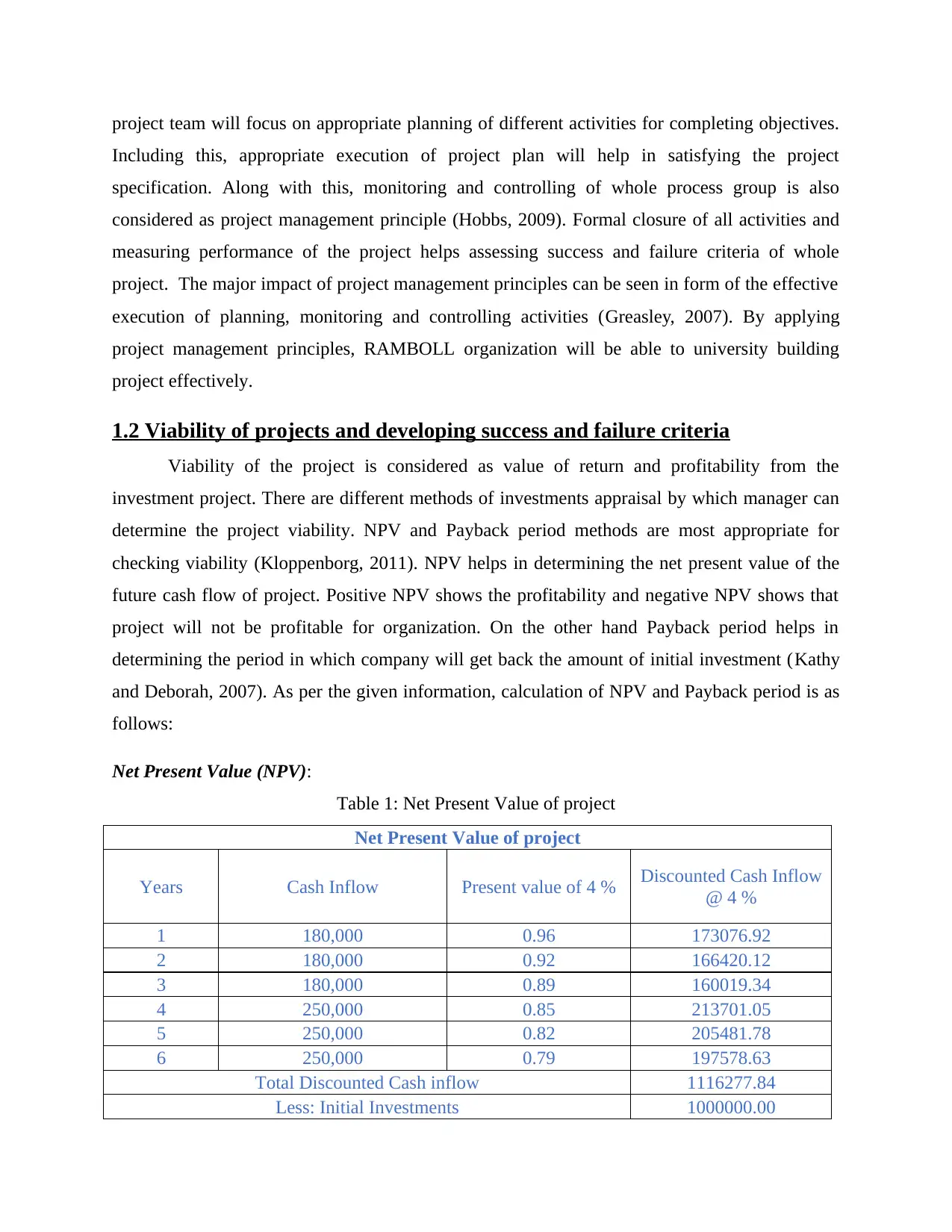
project team will focus on appropriate planning of different activities for completing objectives.
Including this, appropriate execution of project plan will help in satisfying the project
specification. Along with this, monitoring and controlling of whole process group is also
considered as project management principle (Hobbs, 2009). Formal closure of all activities and
measuring performance of the project helps assessing success and failure criteria of whole
project. The major impact of project management principles can be seen in form of the effective
execution of planning, monitoring and controlling activities (Greasley, 2007). By applying
project management principles, RAMBOLL organization will be able to university building
project effectively.
1.2 Viability of projects and developing success and failure criteria
Viability of the project is considered as value of return and profitability from the
investment project. There are different methods of investments appraisal by which manager can
determine the project viability. NPV and Payback period methods are most appropriate for
checking viability (Kloppenborg, 2011). NPV helps in determining the net present value of the
future cash flow of project. Positive NPV shows the profitability and negative NPV shows that
project will not be profitable for organization. On the other hand Payback period helps in
determining the period in which company will get back the amount of initial investment (Kathy
and Deborah, 2007). As per the given information, calculation of NPV and Payback period is as
follows:
Net Present Value (NPV):
Table 1: Net Present Value of project
Net Present Value of project
Years Cash Inflow Present value of 4 % Discounted Cash Inflow
@ 4 %
1 180,000 0.96 173076.92
2 180,000 0.92 166420.12
3 180,000 0.89 160019.34
4 250,000 0.85 213701.05
5 250,000 0.82 205481.78
6 250,000 0.79 197578.63
Total Discounted Cash inflow 1116277.84
Less: Initial Investments 1000000.00
Including this, appropriate execution of project plan will help in satisfying the project
specification. Along with this, monitoring and controlling of whole process group is also
considered as project management principle (Hobbs, 2009). Formal closure of all activities and
measuring performance of the project helps assessing success and failure criteria of whole
project. The major impact of project management principles can be seen in form of the effective
execution of planning, monitoring and controlling activities (Greasley, 2007). By applying
project management principles, RAMBOLL organization will be able to university building
project effectively.
1.2 Viability of projects and developing success and failure criteria
Viability of the project is considered as value of return and profitability from the
investment project. There are different methods of investments appraisal by which manager can
determine the project viability. NPV and Payback period methods are most appropriate for
checking viability (Kloppenborg, 2011). NPV helps in determining the net present value of the
future cash flow of project. Positive NPV shows the profitability and negative NPV shows that
project will not be profitable for organization. On the other hand Payback period helps in
determining the period in which company will get back the amount of initial investment (Kathy
and Deborah, 2007). As per the given information, calculation of NPV and Payback period is as
follows:
Net Present Value (NPV):
Table 1: Net Present Value of project
Net Present Value of project
Years Cash Inflow Present value of 4 % Discounted Cash Inflow
@ 4 %
1 180,000 0.96 173076.92
2 180,000 0.92 166420.12
3 180,000 0.89 160019.34
4 250,000 0.85 213701.05
5 250,000 0.82 205481.78
6 250,000 0.79 197578.63
Total Discounted Cash inflow 1116277.84
Less: Initial Investments 1000000.00
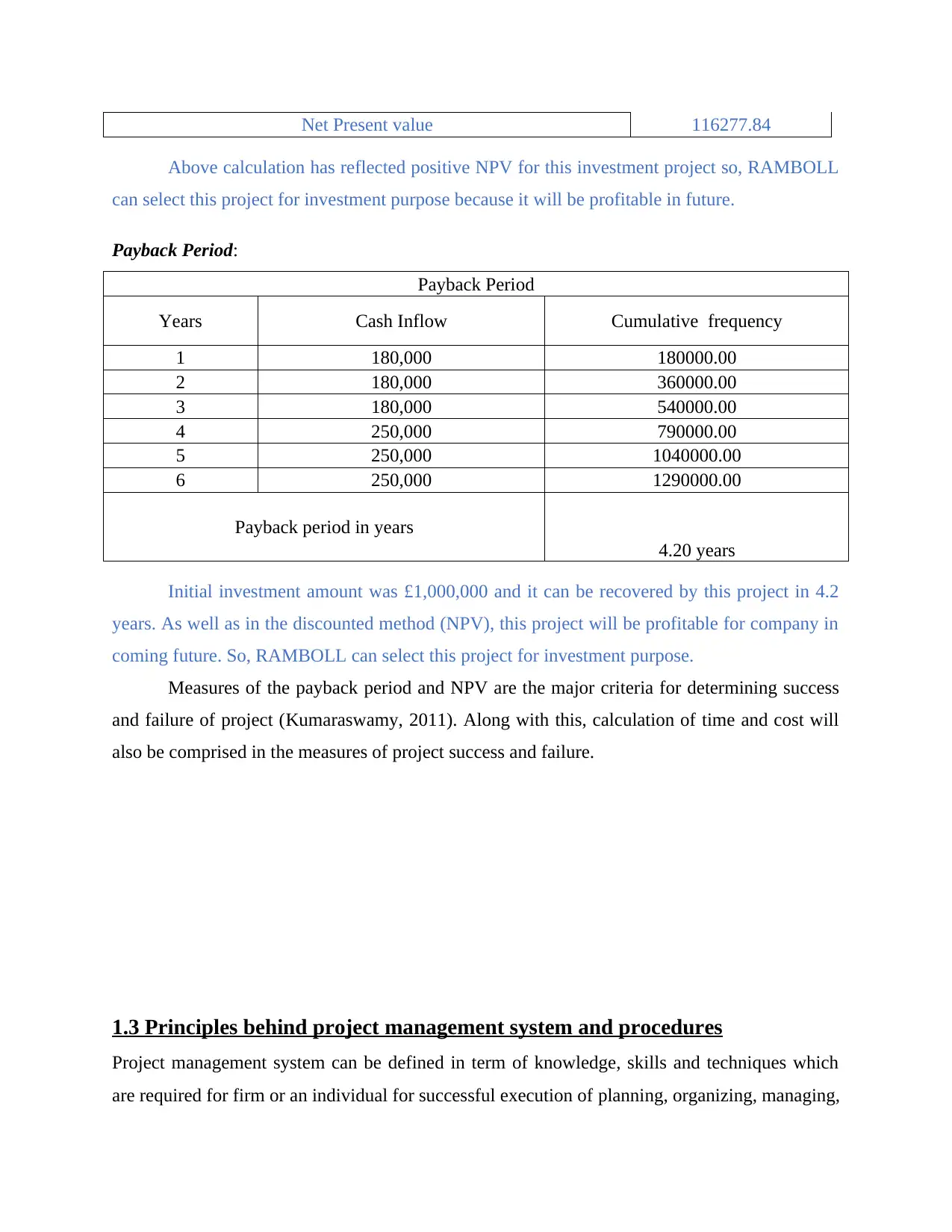
Net Present value 116277.84
Above calculation has reflected positive NPV for this investment project so, RAMBOLL
can select this project for investment purpose because it will be profitable in future.
Payback Period:
Payback Period
Years Cash Inflow Cumulative frequency
1 180,000 180000.00
2 180,000 360000.00
3 180,000 540000.00
4 250,000 790000.00
5 250,000 1040000.00
6 250,000 1290000.00
Payback period in years
4.20 years
Initial investment amount was £1,000,000 and it can be recovered by this project in 4.2
years. As well as in the discounted method (NPV), this project will be profitable for company in
coming future. So, RAMBOLL can select this project for investment purpose.
Measures of the payback period and NPV are the major criteria for determining success
and failure of project (Kumaraswamy, 2011). Along with this, calculation of time and cost will
also be comprised in the measures of project success and failure.
1.3 Principles behind project management system and procedures
Project management system can be defined in term of knowledge, skills and techniques which
are required for firm or an individual for successful execution of planning, organizing, managing,
Above calculation has reflected positive NPV for this investment project so, RAMBOLL
can select this project for investment purpose because it will be profitable in future.
Payback Period:
Payback Period
Years Cash Inflow Cumulative frequency
1 180,000 180000.00
2 180,000 360000.00
3 180,000 540000.00
4 250,000 790000.00
5 250,000 1040000.00
6 250,000 1290000.00
Payback period in years
4.20 years
Initial investment amount was £1,000,000 and it can be recovered by this project in 4.2
years. As well as in the discounted method (NPV), this project will be profitable for company in
coming future. So, RAMBOLL can select this project for investment purpose.
Measures of the payback period and NPV are the major criteria for determining success
and failure of project (Kumaraswamy, 2011). Along with this, calculation of time and cost will
also be comprised in the measures of project success and failure.
1.3 Principles behind project management system and procedures
Project management system can be defined in term of knowledge, skills and techniques which
are required for firm or an individual for successful execution of planning, organizing, managing,
⊘ This is a preview!⊘
Do you want full access?
Subscribe today to unlock all pages.

Trusted by 1+ million students worldwide
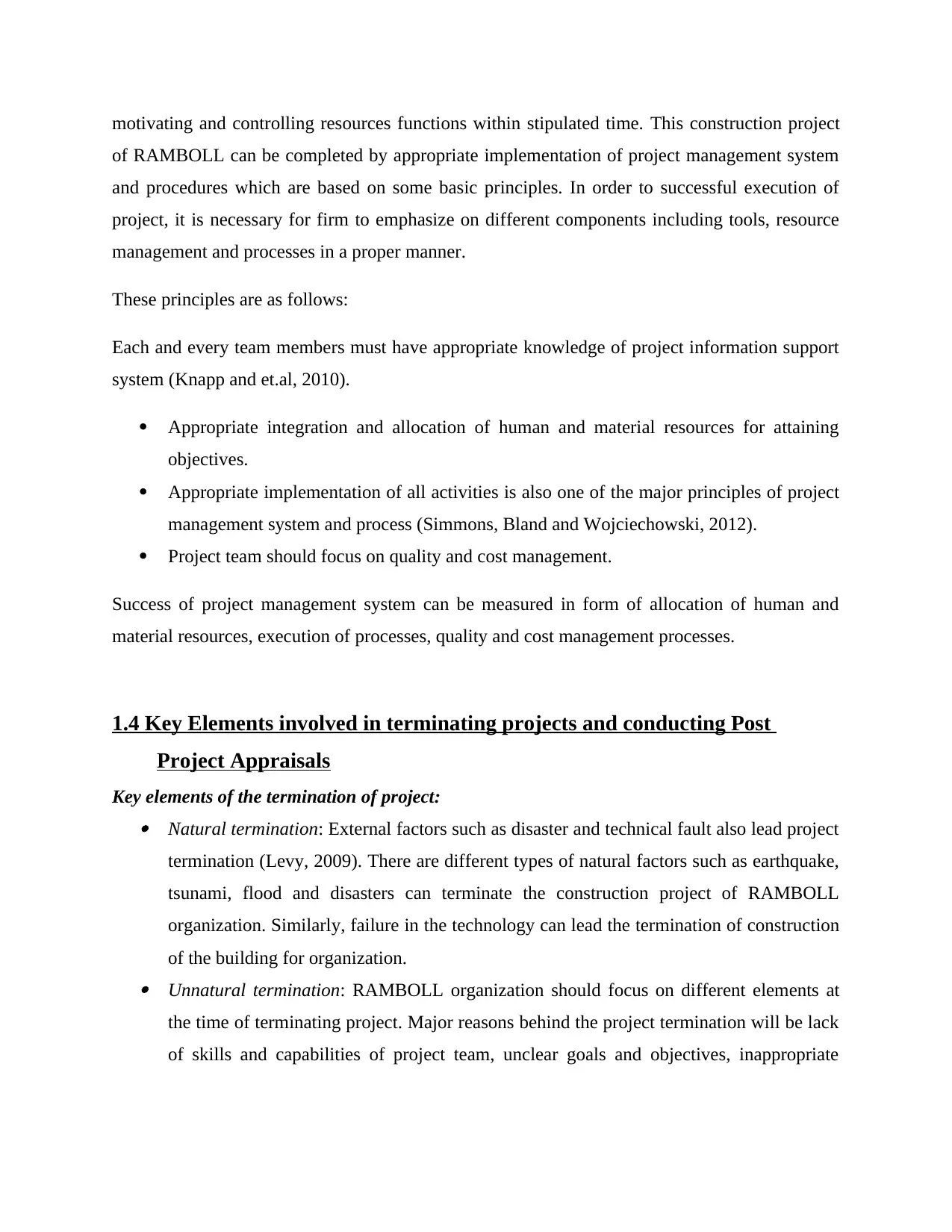
motivating and controlling resources functions within stipulated time. This construction project
of RAMBOLL can be completed by appropriate implementation of project management system
and procedures which are based on some basic principles. In order to successful execution of
project, it is necessary for firm to emphasize on different components including tools, resource
management and processes in a proper manner.
These principles are as follows:
Each and every team members must have appropriate knowledge of project information support
system (Knapp and et.al, 2010).
Appropriate integration and allocation of human and material resources for attaining
objectives.
Appropriate implementation of all activities is also one of the major principles of project
management system and process (Simmons, Bland and Wojciechowski, 2012).
Project team should focus on quality and cost management.
Success of project management system can be measured in form of allocation of human and
material resources, execution of processes, quality and cost management processes.
1.4 Key Elements involved in terminating projects and conducting Post
Project Appraisals
Key elements of the termination of project: Natural termination: External factors such as disaster and technical fault also lead project
termination (Levy, 2009). There are different types of natural factors such as earthquake,
tsunami, flood and disasters can terminate the construction project of RAMBOLL
organization. Similarly, failure in the technology can lead the termination of construction
of the building for organization. Unnatural termination: RAMBOLL organization should focus on different elements at
the time of terminating project. Major reasons behind the project termination will be lack
of skills and capabilities of project team, unclear goals and objectives, inappropriate
of RAMBOLL can be completed by appropriate implementation of project management system
and procedures which are based on some basic principles. In order to successful execution of
project, it is necessary for firm to emphasize on different components including tools, resource
management and processes in a proper manner.
These principles are as follows:
Each and every team members must have appropriate knowledge of project information support
system (Knapp and et.al, 2010).
Appropriate integration and allocation of human and material resources for attaining
objectives.
Appropriate implementation of all activities is also one of the major principles of project
management system and process (Simmons, Bland and Wojciechowski, 2012).
Project team should focus on quality and cost management.
Success of project management system can be measured in form of allocation of human and
material resources, execution of processes, quality and cost management processes.
1.4 Key Elements involved in terminating projects and conducting Post
Project Appraisals
Key elements of the termination of project: Natural termination: External factors such as disaster and technical fault also lead project
termination (Levy, 2009). There are different types of natural factors such as earthquake,
tsunami, flood and disasters can terminate the construction project of RAMBOLL
organization. Similarly, failure in the technology can lead the termination of construction
of the building for organization. Unnatural termination: RAMBOLL organization should focus on different elements at
the time of terminating project. Major reasons behind the project termination will be lack
of skills and capabilities of project team, unclear goals and objectives, inappropriate
Paraphrase This Document
Need a fresh take? Get an instant paraphrase of this document with our AI Paraphraser
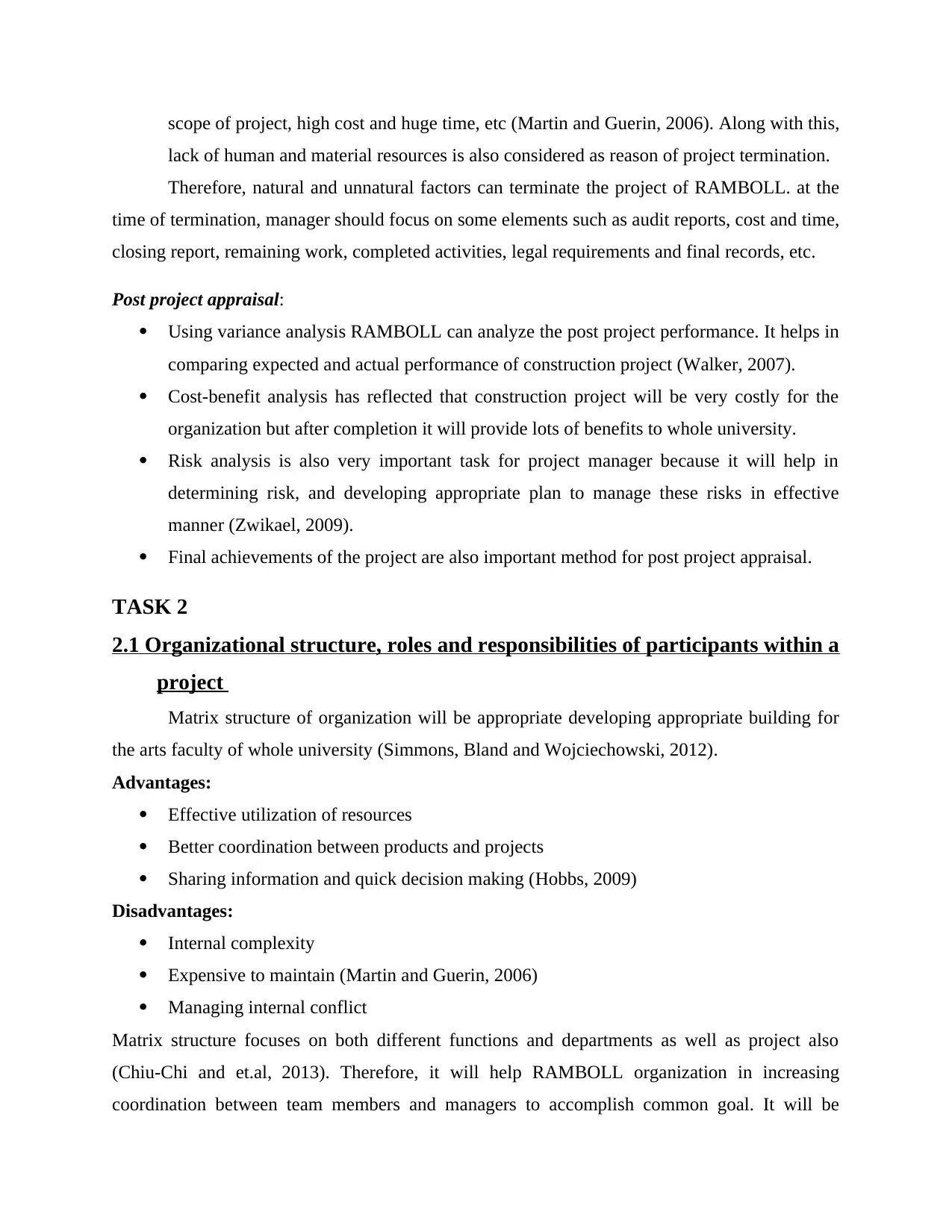
scope of project, high cost and huge time, etc (Martin and Guerin, 2006). Along with this,
lack of human and material resources is also considered as reason of project termination.
Therefore, natural and unnatural factors can terminate the project of RAMBOLL. at the
time of termination, manager should focus on some elements such as audit reports, cost and time,
closing report, remaining work, completed activities, legal requirements and final records, etc.
Post project appraisal:
Using variance analysis RAMBOLL can analyze the post project performance. It helps in
comparing expected and actual performance of construction project (Walker, 2007).
Cost-benefit analysis has reflected that construction project will be very costly for the
organization but after completion it will provide lots of benefits to whole university.
Risk analysis is also very important task for project manager because it will help in
determining risk, and developing appropriate plan to manage these risks in effective
manner (Zwikael, 2009).
Final achievements of the project are also important method for post project appraisal.
TASK 2
2.1 Organizational structure, roles and responsibilities of participants within a
project
Matrix structure of organization will be appropriate developing appropriate building for
the arts faculty of whole university (Simmons, Bland and Wojciechowski, 2012).
Advantages:
Effective utilization of resources
Better coordination between products and projects
Sharing information and quick decision making (Hobbs, 2009)
Disadvantages:
Internal complexity
Expensive to maintain (Martin and Guerin, 2006)
Managing internal conflict
Matrix structure focuses on both different functions and departments as well as project also
(Chiu-Chi and et.al, 2013). Therefore, it will help RAMBOLL organization in increasing
coordination between team members and managers to accomplish common goal. It will be
lack of human and material resources is also considered as reason of project termination.
Therefore, natural and unnatural factors can terminate the project of RAMBOLL. at the
time of termination, manager should focus on some elements such as audit reports, cost and time,
closing report, remaining work, completed activities, legal requirements and final records, etc.
Post project appraisal:
Using variance analysis RAMBOLL can analyze the post project performance. It helps in
comparing expected and actual performance of construction project (Walker, 2007).
Cost-benefit analysis has reflected that construction project will be very costly for the
organization but after completion it will provide lots of benefits to whole university.
Risk analysis is also very important task for project manager because it will help in
determining risk, and developing appropriate plan to manage these risks in effective
manner (Zwikael, 2009).
Final achievements of the project are also important method for post project appraisal.
TASK 2
2.1 Organizational structure, roles and responsibilities of participants within a
project
Matrix structure of organization will be appropriate developing appropriate building for
the arts faculty of whole university (Simmons, Bland and Wojciechowski, 2012).
Advantages:
Effective utilization of resources
Better coordination between products and projects
Sharing information and quick decision making (Hobbs, 2009)
Disadvantages:
Internal complexity
Expensive to maintain (Martin and Guerin, 2006)
Managing internal conflict
Matrix structure focuses on both different functions and departments as well as project also
(Chiu-Chi and et.al, 2013). Therefore, it will help RAMBOLL organization in increasing
coordination between team members and managers to accomplish common goal. It will be
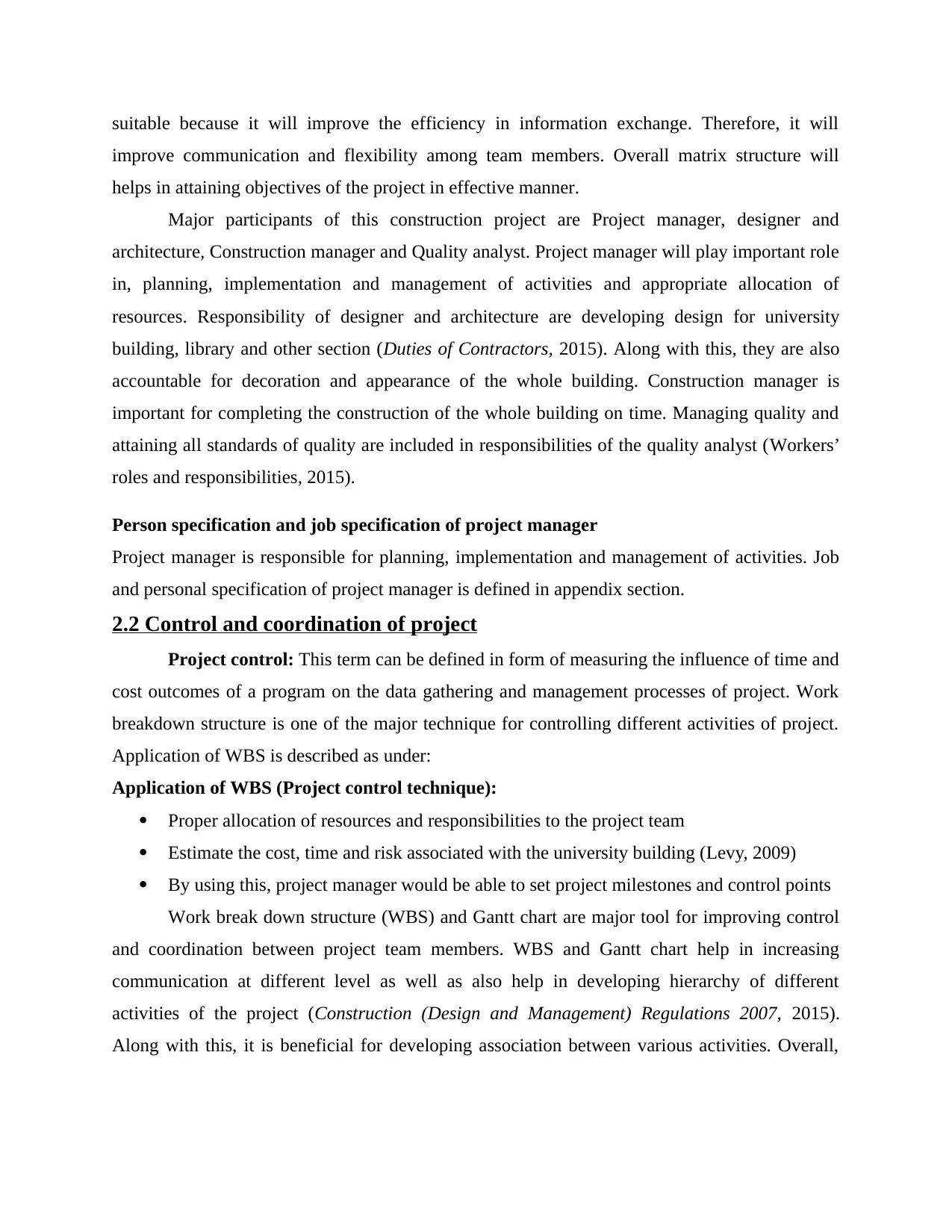
suitable because it will improve the efficiency in information exchange. Therefore, it will
improve communication and flexibility among team members. Overall matrix structure will
helps in attaining objectives of the project in effective manner.
Major participants of this construction project are Project manager, designer and
architecture, Construction manager and Quality analyst. Project manager will play important role
in, planning, implementation and management of activities and appropriate allocation of
resources. Responsibility of designer and architecture are developing design for university
building, library and other section (Duties of Contractors, 2015). Along with this, they are also
accountable for decoration and appearance of the whole building. Construction manager is
important for completing the construction of the whole building on time. Managing quality and
attaining all standards of quality are included in responsibilities of the quality analyst (Workers’
roles and responsibilities, 2015).
Person specification and job specification of project manager
Project manager is responsible for planning, implementation and management of activities. Job
and personal specification of project manager is defined in appendix section.
2.2 Control and coordination of project
Project control: This term can be defined in form of measuring the influence of time and
cost outcomes of a program on the data gathering and management processes of project. Work
breakdown structure is one of the major technique for controlling different activities of project.
Application of WBS is described as under:
Application of WBS (Project control technique):
Proper allocation of resources and responsibilities to the project team
Estimate the cost, time and risk associated with the university building (Levy, 2009)
By using this, project manager would be able to set project milestones and control points
Work break down structure (WBS) and Gantt chart are major tool for improving control
and coordination between project team members. WBS and Gantt chart help in increasing
communication at different level as well as also help in developing hierarchy of different
activities of the project (Construction (Design and Management) Regulations 2007, 2015).
Along with this, it is beneficial for developing association between various activities. Overall,
improve communication and flexibility among team members. Overall matrix structure will
helps in attaining objectives of the project in effective manner.
Major participants of this construction project are Project manager, designer and
architecture, Construction manager and Quality analyst. Project manager will play important role
in, planning, implementation and management of activities and appropriate allocation of
resources. Responsibility of designer and architecture are developing design for university
building, library and other section (Duties of Contractors, 2015). Along with this, they are also
accountable for decoration and appearance of the whole building. Construction manager is
important for completing the construction of the whole building on time. Managing quality and
attaining all standards of quality are included in responsibilities of the quality analyst (Workers’
roles and responsibilities, 2015).
Person specification and job specification of project manager
Project manager is responsible for planning, implementation and management of activities. Job
and personal specification of project manager is defined in appendix section.
2.2 Control and coordination of project
Project control: This term can be defined in form of measuring the influence of time and
cost outcomes of a program on the data gathering and management processes of project. Work
breakdown structure is one of the major technique for controlling different activities of project.
Application of WBS is described as under:
Application of WBS (Project control technique):
Proper allocation of resources and responsibilities to the project team
Estimate the cost, time and risk associated with the university building (Levy, 2009)
By using this, project manager would be able to set project milestones and control points
Work break down structure (WBS) and Gantt chart are major tool for improving control
and coordination between project team members. WBS and Gantt chart help in increasing
communication at different level as well as also help in developing hierarchy of different
activities of the project (Construction (Design and Management) Regulations 2007, 2015).
Along with this, it is beneficial for developing association between various activities. Overall,
⊘ This is a preview!⊘
Do you want full access?
Subscribe today to unlock all pages.

Trusted by 1+ million students worldwide
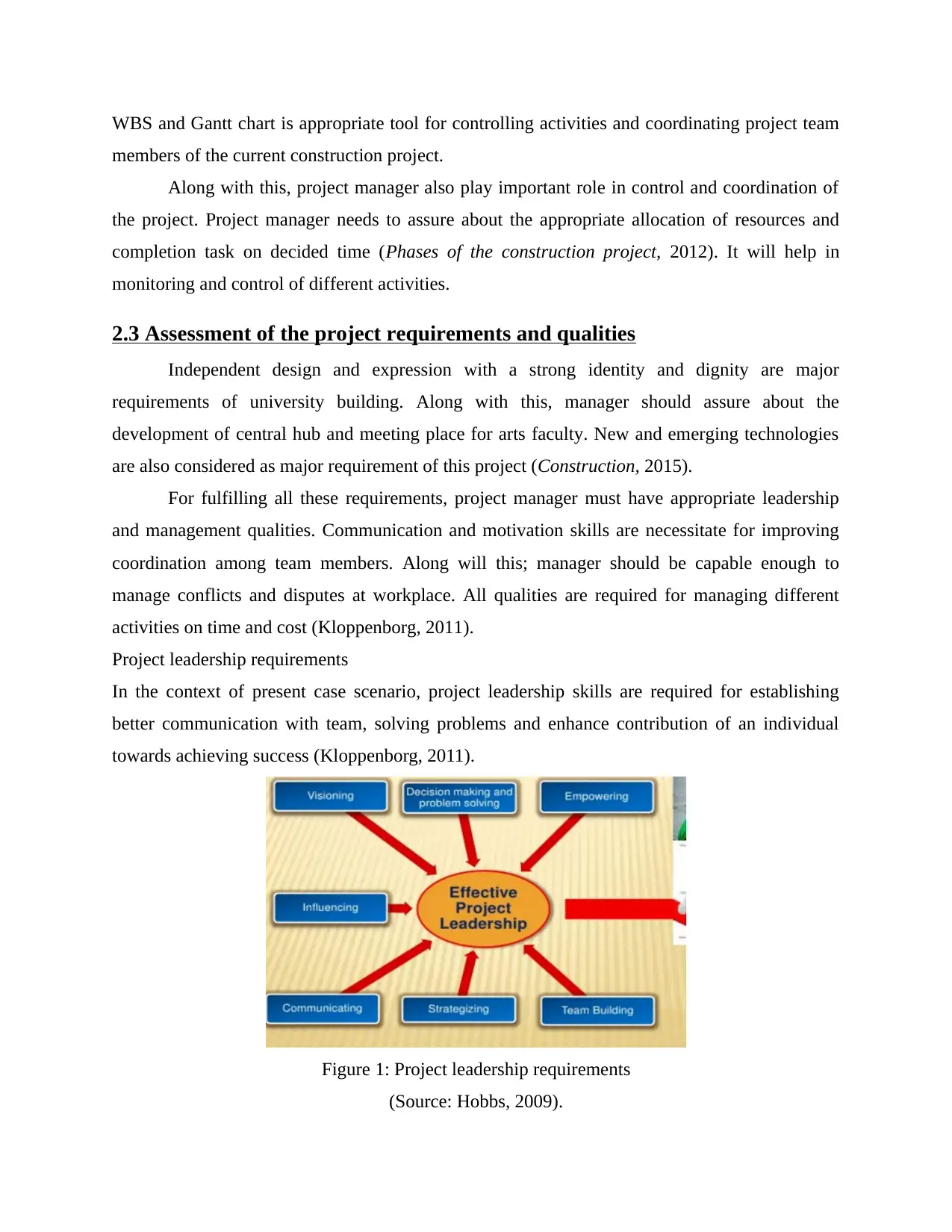
WBS and Gantt chart is appropriate tool for controlling activities and coordinating project team
members of the current construction project.
Along with this, project manager also play important role in control and coordination of
the project. Project manager needs to assure about the appropriate allocation of resources and
completion task on decided time (Phases of the construction project, 2012). It will help in
monitoring and control of different activities.
2.3 Assessment of the project requirements and qualities
Independent design and expression with a strong identity and dignity are major
requirements of university building. Along with this, manager should assure about the
development of central hub and meeting place for arts faculty. New and emerging technologies
are also considered as major requirement of this project (Construction, 2015).
For fulfilling all these requirements, project manager must have appropriate leadership
and management qualities. Communication and motivation skills are necessitate for improving
coordination among team members. Along will this; manager should be capable enough to
manage conflicts and disputes at workplace. All qualities are required for managing different
activities on time and cost (Kloppenborg, 2011).
Project leadership requirements
In the context of present case scenario, project leadership skills are required for establishing
better communication with team, solving problems and enhance contribution of an individual
towards achieving success (Kloppenborg, 2011).
Figure 1: Project leadership requirements
(Source: Hobbs, 2009).
members of the current construction project.
Along with this, project manager also play important role in control and coordination of
the project. Project manager needs to assure about the appropriate allocation of resources and
completion task on decided time (Phases of the construction project, 2012). It will help in
monitoring and control of different activities.
2.3 Assessment of the project requirements and qualities
Independent design and expression with a strong identity and dignity are major
requirements of university building. Along with this, manager should assure about the
development of central hub and meeting place for arts faculty. New and emerging technologies
are also considered as major requirement of this project (Construction, 2015).
For fulfilling all these requirements, project manager must have appropriate leadership
and management qualities. Communication and motivation skills are necessitate for improving
coordination among team members. Along will this; manager should be capable enough to
manage conflicts and disputes at workplace. All qualities are required for managing different
activities on time and cost (Kloppenborg, 2011).
Project leadership requirements
In the context of present case scenario, project leadership skills are required for establishing
better communication with team, solving problems and enhance contribution of an individual
towards achieving success (Kloppenborg, 2011).
Figure 1: Project leadership requirements
(Source: Hobbs, 2009).
Paraphrase This Document
Need a fresh take? Get an instant paraphrase of this document with our AI Paraphraser
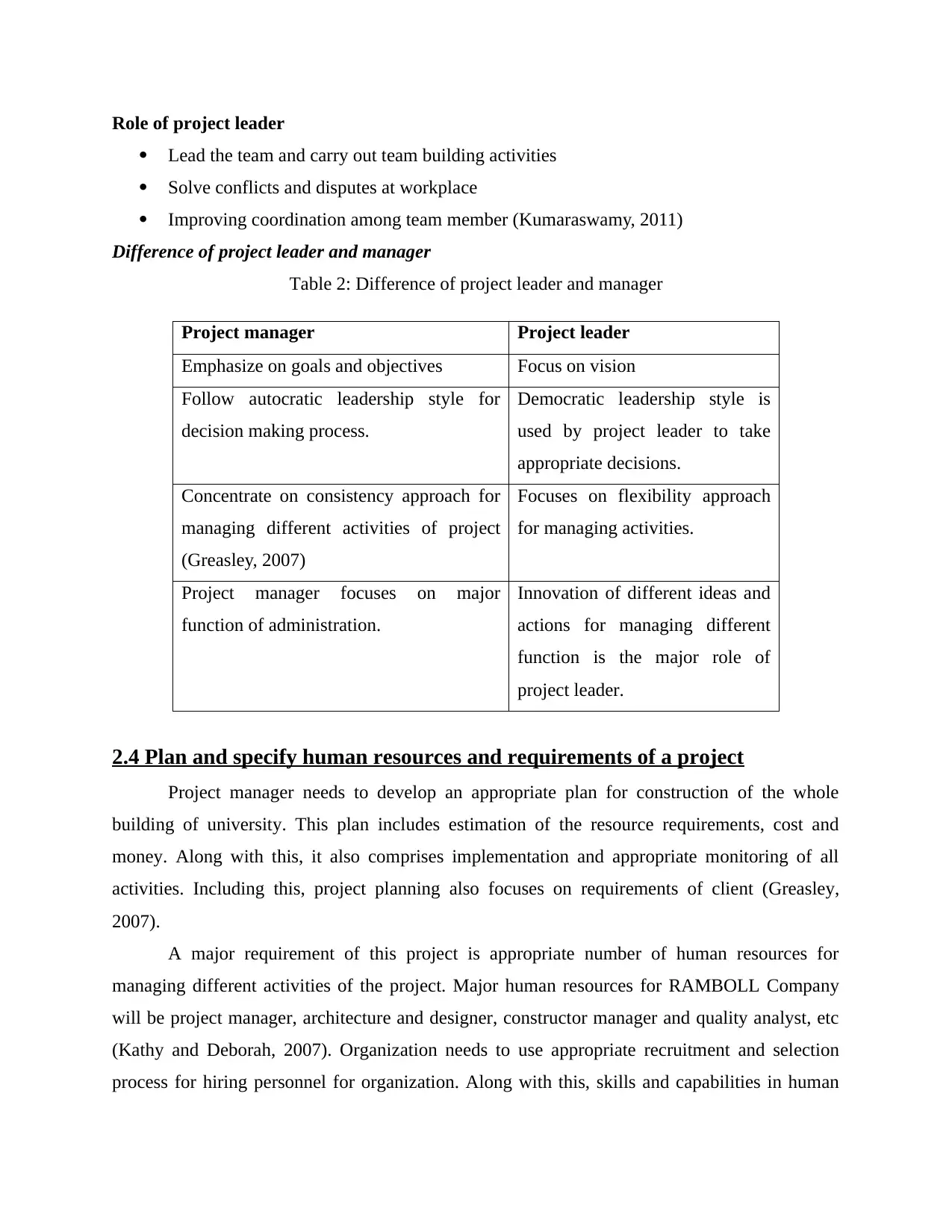
Role of project leader
Lead the team and carry out team building activities
Solve conflicts and disputes at workplace
Improving coordination among team member (Kumaraswamy, 2011)
Difference of project leader and manager
Table 2: Difference of project leader and manager
Project manager Project leader
Emphasize on goals and objectives Focus on vision
Follow autocratic leadership style for
decision making process.
Democratic leadership style is
used by project leader to take
appropriate decisions.
Concentrate on consistency approach for
managing different activities of project
(Greasley, 2007)
Focuses on flexibility approach
for managing activities.
Project manager focuses on major
function of administration.
Innovation of different ideas and
actions for managing different
function is the major role of
project leader.
2.4 Plan and specify human resources and requirements of a project
Project manager needs to develop an appropriate plan for construction of the whole
building of university. This plan includes estimation of the resource requirements, cost and
money. Along with this, it also comprises implementation and appropriate monitoring of all
activities. Including this, project planning also focuses on requirements of client (Greasley,
2007).
A major requirement of this project is appropriate number of human resources for
managing different activities of the project. Major human resources for RAMBOLL Company
will be project manager, architecture and designer, constructor manager and quality analyst, etc
(Kathy and Deborah, 2007). Organization needs to use appropriate recruitment and selection
process for hiring personnel for organization. Along with this, skills and capabilities in human
Lead the team and carry out team building activities
Solve conflicts and disputes at workplace
Improving coordination among team member (Kumaraswamy, 2011)
Difference of project leader and manager
Table 2: Difference of project leader and manager
Project manager Project leader
Emphasize on goals and objectives Focus on vision
Follow autocratic leadership style for
decision making process.
Democratic leadership style is
used by project leader to take
appropriate decisions.
Concentrate on consistency approach for
managing different activities of project
(Greasley, 2007)
Focuses on flexibility approach
for managing activities.
Project manager focuses on major
function of administration.
Innovation of different ideas and
actions for managing different
function is the major role of
project leader.
2.4 Plan and specify human resources and requirements of a project
Project manager needs to develop an appropriate plan for construction of the whole
building of university. This plan includes estimation of the resource requirements, cost and
money. Along with this, it also comprises implementation and appropriate monitoring of all
activities. Including this, project planning also focuses on requirements of client (Greasley,
2007).
A major requirement of this project is appropriate number of human resources for
managing different activities of the project. Major human resources for RAMBOLL Company
will be project manager, architecture and designer, constructor manager and quality analyst, etc
(Kathy and Deborah, 2007). Organization needs to use appropriate recruitment and selection
process for hiring personnel for organization. Along with this, skills and capabilities in human
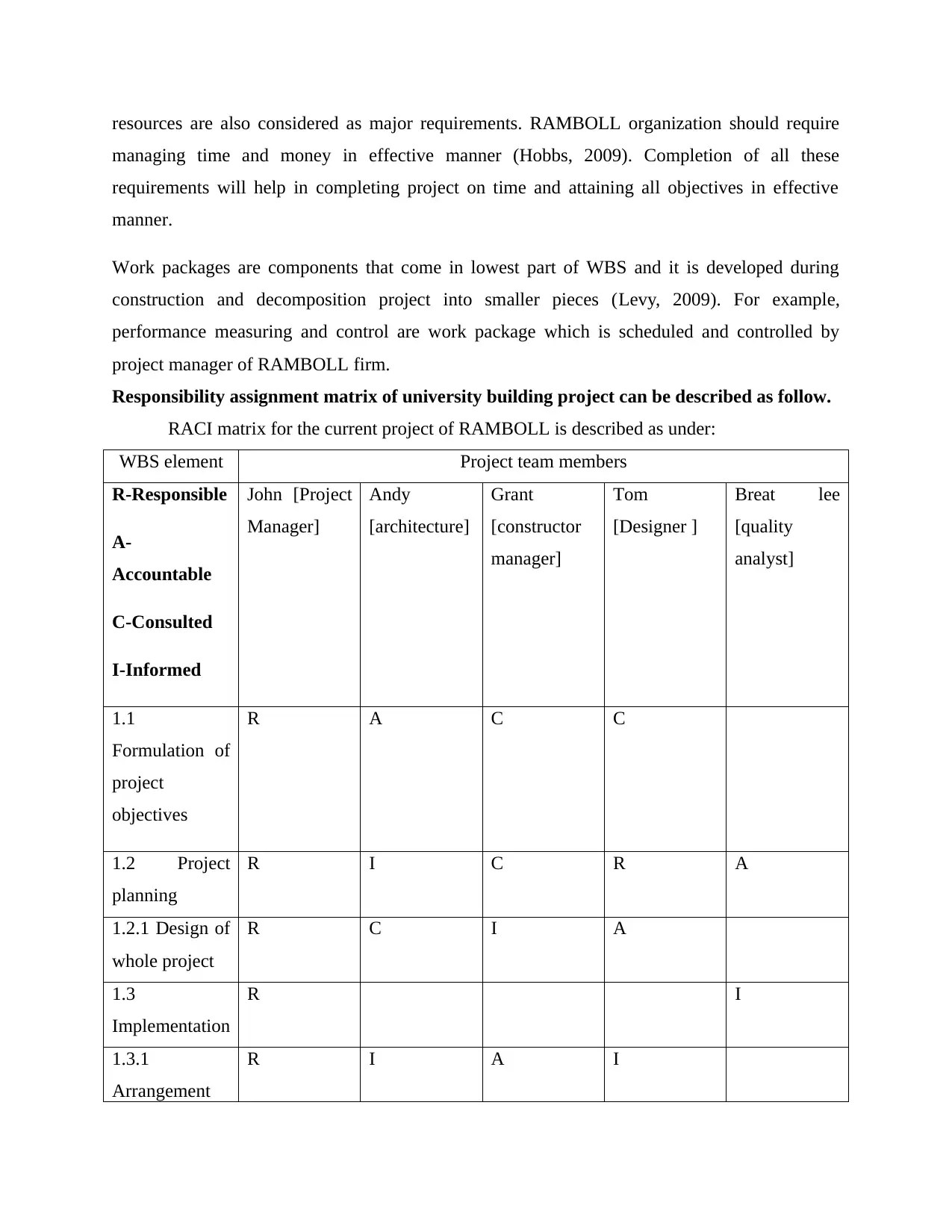
resources are also considered as major requirements. RAMBOLL organization should require
managing time and money in effective manner (Hobbs, 2009). Completion of all these
requirements will help in completing project on time and attaining all objectives in effective
manner.
Work packages are components that come in lowest part of WBS and it is developed during
construction and decomposition project into smaller pieces (Levy, 2009). For example,
performance measuring and control are work package which is scheduled and controlled by
project manager of RAMBOLL firm.
Responsibility assignment matrix of university building project can be described as follow.
RACI matrix for the current project of RAMBOLL is described as under:
WBS element Project team members
R-Responsible
A-
Accountable
C-Consulted
I-Informed
John [Project
Manager]
Andy
[architecture]
Grant
[constructor
manager]
Tom
[Designer ]
Breat lee
[quality
analyst]
1.1
Formulation of
project
objectives
R A C C
1.2 Project
planning
R I C R A
1.2.1 Design of
whole project
R C I A
1.3
Implementation
R I
1.3.1
Arrangement
R I A I
managing time and money in effective manner (Hobbs, 2009). Completion of all these
requirements will help in completing project on time and attaining all objectives in effective
manner.
Work packages are components that come in lowest part of WBS and it is developed during
construction and decomposition project into smaller pieces (Levy, 2009). For example,
performance measuring and control are work package which is scheduled and controlled by
project manager of RAMBOLL firm.
Responsibility assignment matrix of university building project can be described as follow.
RACI matrix for the current project of RAMBOLL is described as under:
WBS element Project team members
R-Responsible
A-
Accountable
C-Consulted
I-Informed
John [Project
Manager]
Andy
[architecture]
Grant
[constructor
manager]
Tom
[Designer ]
Breat lee
[quality
analyst]
1.1
Formulation of
project
objectives
R A C C
1.2 Project
planning
R I C R A
1.2.1 Design of
whole project
R C I A
1.3
Implementation
R I
1.3.1
Arrangement
R I A I
⊘ This is a preview!⊘
Do you want full access?
Subscribe today to unlock all pages.

Trusted by 1+ million students worldwide
1 out of 24
Related Documents
Your All-in-One AI-Powered Toolkit for Academic Success.
+13062052269
info@desklib.com
Available 24*7 on WhatsApp / Email
![[object Object]](/_next/static/media/star-bottom.7253800d.svg)
Unlock your academic potential
Copyright © 2020–2025 A2Z Services. All Rights Reserved. Developed and managed by ZUCOL.





